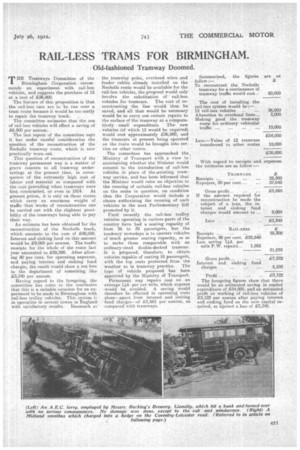RAIL-LESS TRAMS FOR BIRMINGHAM.
Page 9

If you've noticed an error in this article please click here to report it so we can fix it.
Old-fashioned Tramway Doomed.
THE Tramways Committee of the Birmingham Corporation recommends an experiment with rail-less vehicles, and suggests the purchase of 12 at a Cost of £36,000.
The feature of this proposition is that the rail-less cars are to be run over a tram route because it would be too costly to repair the tramway track. .
• The committee estimates that the use of rail-less vehicles will effect a saving of 2,6,500 per annum.
The last report, of the committee says it has under careful consideration the question of the reconstruction of the Nechells tramway route, which is now practically worn-out.
This question of reconstruction of the tramway permanent way is a matter of grave concern to all tramway undertakings at the present. time, in consequence of the extremely high cost of labour and material as compared with the cost prevailing when tramways were first constructed, or even in 1914, At present prices, it is only on those routes which carry an enormous weight of traffic that works of reconstruction can be carried out with the slightest possibility of the tramways being able to pay their way.
An estimate has been obtained for the reconstruction of the Nechells track, which amounts to the sum of £90,000. Interest and sinking fund on this amount would be £9,000 per annum. The tralac receipts for the whole or the route last year amounted to 228,300. After allowing 80 per cent, for operating expenses, and paying interest and sinking fund charges, the result would show a net loss to the, department of something like £3,340 per annum.
Raving regard to the foregoing, the committee has come to the conclusion that this is a suitable occasion for an experiment to be made in Birmingham with rail-less trolley vehicles. This system is in operatiOn in several towns in England with satisfactory results. Inasmuch as the tramway poles, overhead wires and feeder cables already installed on the Nechells route would be available for the rail-less vehicles, the proposal would only involve the substitution Of rail-less vehicles for tramcars. The cost of reconstructing the line would thus be saved, and all that would be necessary would be to carry .out certain repairs to the surface of the tramway at a comparatively small :expenditure. The. new vehicles (of which 12 would be required) would cost approximately £36,000, and the tramcars at present being operated on the route would be brought into service on other routes.
The committee has approached the, Ministry of Transport with a view to ! ascertaining whether the Minister would consent to the introduction of rail-less vehicles in place of the i,existing tramway service, and has been informed that the Minister would raise no objection to the running of suitable rail-less vehicles on the route in question, on condition that the Corporation would include a clause authorizing the running of such vehicles in the next Parliamentary Bill promoted by it.
Until recently the rail-less trolley vehicles operating in various parts of the country have had a seating capacity of from 26 to 30 passengers, but the tendency nowadays is to onerate vehicles of much greater seating capacity, so as to make them comparable with an ordinary-sized double-decked tramcar. It is proposed, therefore, to obtain vehicles capable of seating 51 passengers, with the top seats protected from the weather as in tramway practice. The type of vehicle proposed has been approved by the Ministry of Transport.
Permanent way repairs cost an an average lid. per car mile, which expense would be avoided. A saving would therefore be effected in operating costs alone—apart from interest and sinking fund charges—of £1,562 per •anatnn, as compared with tramways. Summarized, the figures are as follow:— To reconstruct the Nechells tramway for a continuance of tramway traffic would cost... 90,000 The -cost of installing the rail-leas system would be: 12 rail-less vehicles ... 36,000 Alteration to overhead lines... 3,000 Making good the tramway route for ordinary vehicular 15,000 £54,000 Less.—Value of 12 tramcars transferred to other routes 18,000 £36,000 With regard to receipts and expenses the estimates are as follow:— TRAMWAYS.
Receipts ... 28,300
Expenses, ao per cent.... ... 22,640
Gross profit... ... £5,660 If the amount required for reconstruction be made the subject of a loan, the interest and sinking fund charges would amount to ... 9,000 £3,340 RAIL-LESS.
Receipts 28,300 Expenses, 80 per cent. 222,640 Less saving 11d. per mile P.W. repairs... 1,562 21,078 Gross profit... £7,222 Interest and sinking fund charges , 4,100 Profit ... £3,122 The foregoing figures show that there would be an estimated saving in capital expenditure of .254,000, and an estimated profit on working of rail-less vehicles of £3,122 per annum after paying interest and sinking fund on the new capital required, as against a loss of £3,340.
































